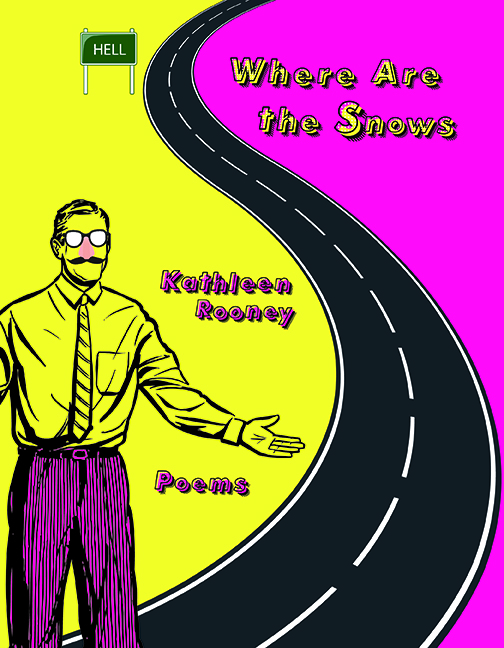Kathleen Rooney
Ninth Letter is pleased to offer three poems from Kathleen Rooney’s poetry collection, Where Are the Snows, winner of the 2022 X. J. Kennedy Prize, poems that stare unblinkingly at our current 21st-century dilemmas. As she writes in “The Surroundings in Which an Animal or Plant Lives or Operates”:
Despicable, that concept we call “the apocalypse”—too neat, too total. At best, the end of the world gives us a lick and a promise. Like us, it’s an animal that likes to play with its food.
—PG
The Life of the Mind
Train tracks across flat land seem infinite. But at a point not visible, they do have an end.
For Wittgenstein, concepts resemble tools and they, like tools, can cease to be useful. It isn’t tragic.
Someone said to me about a photo of Audrey Hepburn, “She even looks glamorous reading.” I said, “Now that you mention it, everyone looks glamorous reading.”
Maybe people who dismiss style as frivolous are jealous. Who does it hurt if I flounce around in my fanciest dress?
In 1999, I read The End of History. But the joke’s on you, Francis Fukuyama! History keeps pouring out like slurry from a factory that manufactures something besides liberal democracy.
Aporia, in rhetoric, is a useful expression of doubt.
Will professional thinkers ever abandon dialectical tensions? I doubt it. Remind yourself daily that this is temporary.
The 22nd Century. Who can say the phrase out loud?
A friend wrote to me that in Chinese there are five seasons, not four: summer, fall, winter, spring, and the season-in-between. In English we don’t have a word for that which separates after from before.
A little epistemic humility can be worth a try. The best philosophers admit they have no idea what they’re talking about.
The train tracks of thought can become sclerotic. Regarding beauty reduces inflammation.
I can easily imagine the end of the world and the end of capitalism
Can’t wait to catch you on the other side, where the blank page holds its breath and waits.
The Surroundings in Which an Animal or Plant Lives or Operates
April feels crueler than usual this year.
Yesterday was the 50th anniversary of Earth Day. Four and a half billion years ago, the planet’s birthday happened, but in what month we’ll never know.
Three days ago marked the 10th anniversary of the BP Deepwater Horizon Oil Spill. How long until the next despoilment?
Earth is the solid footing formed of soil. Earth is the sphere of mortal life, as distinguished from the spheres of spirits.
Inaccurate to claim that “humans are the real virus.” But fair to say some of us are the scum of the earth.
In March, a false tweet about dolphins returning to the formerly squalid canals of Venice got 40,000 likes. “Nature just hit the reset button on us,” typed some guy.
Nice try, but humans constitute and are constituted by nature. Animals all, we do not stand apart. There is no away, there is no outside.
The virus is as thin as one-thousandth the width of an eyelash. A human eyelash, we mean, relating everything always to us.
My friend Sarah’s mom sent her a lamb cake over Easter. “I thought it would be made of ground up lamb,” she emailed me. “Really, it’s a very cute lamb-shaped vanilla cake with coconut frosting.”
The prospect of killing animals ought to be more disgusting.
In his essay “Bad News,” John Berger wrote, “COMPASSION need not be written with capital letters. It simply involves a recognition of losses which are not, at the first degree, one’s own.”
On a walk last week, we saw a bird smushed on the asphalt in the crosswalk. Looked it up in the Cornell ornithology app. A hermit thrush. Whose fault the window? Whose fault the crash?
I don’t know if people who’ve never seen them can comprehend how great the Great Lakes are. Tapestries of sky and beach. Lake Michigan thrashing the sand, a Midwestern Ocean.
When Saint Jerome was living out in the boondocks, he tamed the King of Beasts by pulling a thorn from its paw. Every medieval rendering—fleshy hand upon feline claw— reveals tenderness, as well as the fact that the painter had probably never seen a real lion.
Until not too many centuries ago, people still believed in the existence of unicorns: white, horse-like, tameable by a virgin. Marco Polo claimed this image was all wrong. Actual unicorns were black and ill-tempered, enormous and ugly. (What he’d seen turned out to have been a rhinoceros.)
A fall to earth. A massive earthquake. What on earth is going to happen next?
Bernard-Henri Lévy tweeted that the coronavirus was not a black swan but a gray rhinoceros. The difference, he said: “The second was predictable, announced, but, like the ostriches we put our heads in the sand and we didn’t want to listen.” Ostriches don’t really behave that way, but point taken.
Despicable, that concept we call “the apocalypse”—too neat, too total. At best, the end of the world gives us a lick and a promise. Like us, it’s an animal that likes to play with its food.
Atmospheric Water Vapor Frozen into Ice Crystals
According to the original timeline, today is Tax Day.
Chicago wakes to a winter weather advisory. Whirligigs of water in solid form.
Like Prince told us, sometimes it snows in April.
An asteroid the size of a house will fly by Earth today, safely as the flakes fall beyond our windows. The astronomer in the video explained, “Space is pretty big.”
One of my spouse’s co-workers signed an email, “Hope Spring is eternal!”What is the spiritual purpose of snow? Frost on the pane suggests delicacy of feeling.
Some snow spackles down like lumps of plaster. But the snow of late spring has a rarified quality. Like Swans Down cake flour, made from soft winter wheat and sifted repeatedly to be finer than all-purpose.
Scientific study says that twenty minutes of nature significantly lowers stress. The snow in the twilight, a pale blue sugar.
Ukichiro Nakaya developed a crystal morphology diagram of the diversity of snowflakes. He also made the world’s first artificial snow.
The Sahara Desert was verdant at one time. Soon enough, the summer will be a swelter of melting ice pops. The globe a welter of melting ice caps.
How does snow feel about being slang for cocaine? Or a mass of static on a television screen? How does snow feel regarding snow jobs?
The birdbath with its disk of ice. Death with its ice-cold marble face. Death as phenomenon, death as concept.
What indignity to be a snowman. Peed on by dogs, head knocked off. Deliquescing.
We read “Silent Snow, Secret Snow” by Conrad Aiken in high school. “Miss Buell was saying ‘Land of perpetual snow’”—and before you know it, the protagonist has gone insane: “a secret screen of snow between himself and the world.” It gets classified as horror, but it sounds okay.
Snowbank, snowball, snowbird, snow-blind. A blizzard makes everybody look ambiguous, like angels.
O, heights of ecstasy! O, throes of despair! Emotion is not a state but a process. In that sense every person creates their own weather.
Snow me under. Wake me when it’s over. (But I know, I know. It’s never over.)
 Kathleen Rooney is the author, most recently, of the novel Cher Ami and Major Whittlesey. Her poetry collection Where Are the Snows, winner of the X. J. Kennedy Prize, is forthcoming from Texas Review Press in fall 2022, and her novel From Dust to Stardust will be published by Lake Union next year. She lives in Chicago, with her spouse, the writer Martin Seay, and teaches at DePaul.
Kathleen Rooney is the author, most recently, of the novel Cher Ami and Major Whittlesey. Her poetry collection Where Are the Snows, winner of the X. J. Kennedy Prize, is forthcoming from Texas Review Press in fall 2022, and her novel From Dust to Stardust will be published by Lake Union next year. She lives in Chicago, with her spouse, the writer Martin Seay, and teaches at DePaul.
